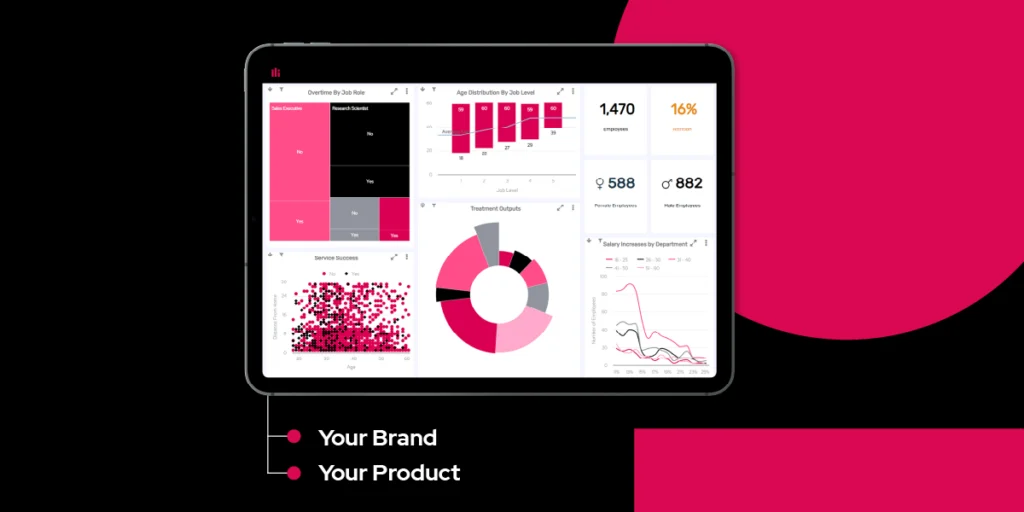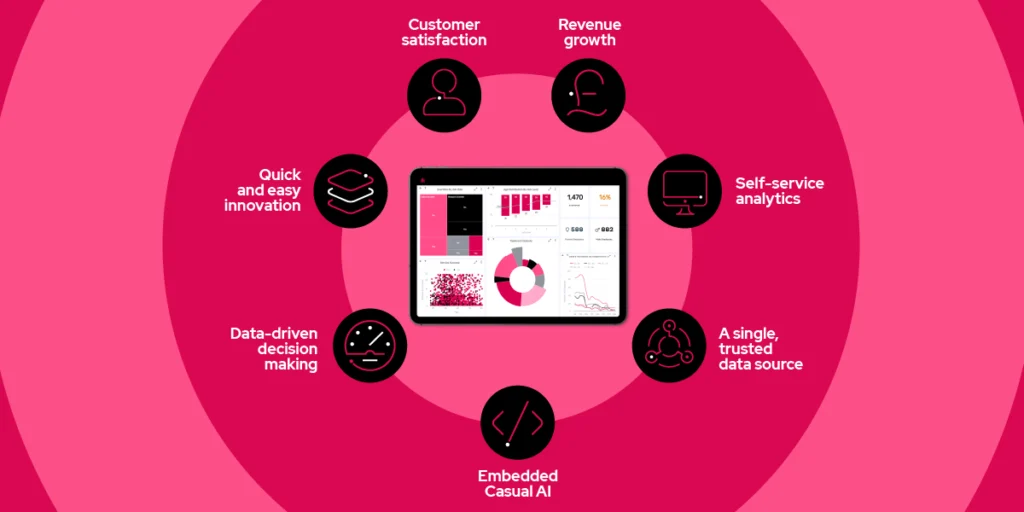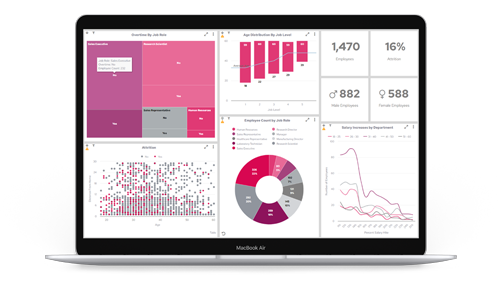Fintech SaaS success is won or lost based on the quality of the experience you deliver to customers, partners, and employees. Experiences that are built entirely on data. Because skillfully using data can create real value—not to mention capture market share.
But there's a problem.
If you're not a data whiz, you usually depend on analysts and data scientists who can turn data into clear, actionable insights. This leads to a constant backlog of requests for data teams. Meanwhile, the rest of us have to rely on our instincts.
But it doesn’t need to be like that. And that’s exactly what we’ll unpack in the next blog in our Fintech SaaS series.
The rise of no-code/low-code
The expectation from Fintech SaaS customers is high, and it’s only going to get higher. User-friendly delivery of clear and concise answers is the benchmark, and self-serve is fast becoming the ‘norm’. If you’re delivering a solution that is difficult to navigate or presents data in a confusing manner, users will simply move to a competitor.
Since its debut in the 1980s, no-code has changed the game when it comes to developing applications—and launching them at speed. The debate on the pros and cons of traditional code vs no-code remains healthy, bringing with it a prominent rise for the field of embedded analytics.

(Example of Panintelligence dashboard)
This visual approach to software development—lets you build applications and processes with no or little coding/expertise. And Fintech teams are reaping the rewards:
- The rapid speed-to-market that embedded analytics empowers is every VP of Product’s dream.
- Its low cost and high reward track record satisfies even the weariest of CFOs.
- How it allows SaaS Fintechs to respond and serve an ever-changing market eases the pressure on CTOs tasked with staying ahead.
By democratizing data visualization through simple drag-and-drop interfaces embedded in your product (with your branding)—you can rapidly gain a competitive advantage.
The Fintech SaaS embedded advantage
Far from just surviving against a backdrop of hesitant investment, Fintech/Fintech SaaS businesses want to thrive. The sector urges the development and roll-out of products at absolute lightning speed—as fast as customer demands change and market boundaries shift.
The state of constant innovation, bringing with it both new opportunities and threats, sets a pace that just can’t be met by traditional coding methods. Fintech SaaS needs to add value quickly, something that can’t be done when your development cycle is long and drawn out.
The people behind-the-scenes of some of the most advanced financial technology and SaaS platforms usually come from a highly trained technical background. But the same isn’t always said for customer-facing employees—sales, marketing, even operations. The empowerment that embedded analytics drag-and-drop configuration or graphical user interface gives to non-technical employees shouldn’t be underestimated.
The entire team can take some responsibility for the product, supporting synchronicity across the business. As Mike says; “There's starting to be a shift in financial services, with more organizations going for commercial, off-the-shelf products that they can then configure themselves. That’s got longevity in it.”
The benefits of embedded analytics for Fintech SaaS
The integration of embedded analytics brings with it a multitude of benefits that have the potential to radically improve both the operation of your business and the delivery of services to customers. This includes:
Data-driven decisions
Embedded analytics empower companies to harness their data effectively. By integrating analytics, you can transform raw data into actionable insights, enabling strategic decisions based on real-time information. For example, you can visualize data trends and patterns, which can help identify opportunities and mitigate risks.
Rapid and easy innovation
By embedding analytics, you can quickly adapt to market changes and customer needs. This agility is essential in a fast-paced industry.
Improved customer satisfaction
Embedded self-service dashboards allow customers to access and analyze their data independently, uncovering the insights that lie within it. Independent data analysis empowers customers to make informed decisions and improve their overall experience.
Revenue growth
Drive revenue by identifying new opportunities and optimizing existing processes. By leveraging data insights, you can uncover trends and patterns that lead to increased sales and profitability. Ultimately, data-driven strategies can contribute to sustainable revenue growth.
Self-service analytics
Self-service analytics empower users to explore and analyze data without relying on data specialists, making data more accessible to everyone and fosters a data-driven culture. Employees at all levels can make informed decisions based on real-time data.
A single, trusted data source
Having a single, trusted data source is essential for accurate and consistent reporting. Embedded analytics solutions consolidate data from various sources into one unified platform, ensuring that everyone in your organization is working with the same information.
A single, trusted data source eliminates discrepancies and improves data integrity, helping to build trust and increase collaboration across teams.
Easy embedding of Causal AI
Embedding Causal AI into Fintech SaaS platforms can provide deeper insights and more accurate predictions, leading to better decision-making and improved business outcomes.

But the embedded analytics advantage doesn’t just benefit your business and customers. The beauty of embedded analytics is that it upholds compliance too.
How embedded analytics upholds compliance for Fintech SaaS
Despite the complex nature of the industry’s standards and regulations, mechanisms built into embedded analytics platforms make adherence incredibly simple. Multi-factor authentication, permissions settings, encryption—you name it, embedded analytics takes away the compliance headache that’s often brought about with changes to financial tech.
The embedded nature of solutions means that it aligns with your security model, and it never moves your data, ensuring full data integrity and governance. Which means SaaS vendors are free to tweak the tools to serve their product, and their customers, best—rather than being solutions that require data to be transferred to an external environment.
SaaS vendors then get the best of both worlds. Firstly, a no or low code solution that is compliant with regulations. Secondly, a range of tools and features, like analytics and dashboards, that can be customized to serve their product, and their users, best.
So, if embedded analytics makes so much sense, the question then becomes: Should you develop in-house or outsource?
Embedded analytics: To develop in-house or outsource?
Let’s be honest, it feels like the question that comes up from development teams “Why don’t we just build it?” has finally been put to bed. Developers have become an expensive scarce resource, who are critical to the ongoing success of a vendor’s product.
With the buy vs build barrier removed, product teams are finding it easier to partner with the right solution to embed and development teams are 100% engaged.
Although budget is one consideration, it’s build speed and time-to-market that’s even more critical to consider. Being slow to market allows competitors to gain the upper hand and can mean the difference between project success or failure.
| Build | Buy |
|---|---|
 Up to 12 months devlopment time Up to 12 months devlopment time |  Go-to-market in weeks Go-to-market in weeks |
 Drain on your resources Drain on your resources |  Access to dedicated specialists Access to dedicated specialists |
 Unpredictable results Unpredictable results |  Unified brand experience Unified brand experience |
 Technical debt Technical debt |  Extension to your dev team Extension to your dev team |
 Data security risks Data security risks |  No data is moved No data is moved |
So what are the other key reasons why Fintech SaaS vendors are partnering with embedded analytics specialists like Panintelligence, rather than building in-house? You can download our buyer's guide here, or read a quick summary of the key reasons below:
1. Time
Things move very quickly at SaaS companies. Your development team is flat-out managing and delivering on core IP and ensuring customers remain happy on your platform, this ensures you keep your retention rate high.
2. Resources
Development resources are scarce and highly sought after. On the flip side, to retain the talent you have, you need to ensure dev teams are motivated to deliver on the product roadmap and core IP. But it’s not just dev teams that get drawn into the build process. QA teams need to test the solution. Documentation needs writing up. Teams need to support it. And of course, bugs will need fixing, libraries updating, and customers will demand new features.
3. Unified brand experience
Key to any embedded analytics platform must be the ability to easily white label the solution to ensure a seamless experience for your customers and their users. Ensuring a unified brand experience across your platform helps to engage your users and drives better adoption of new features.
4. Technical debt
Dev teams are constantly looking at ways to avoid ‘technical debt’. Like avoiding shortcuts that may come back to bite them later. Plus, libraries need updating, security updates are important to be up to date on, and the dreaded depreciation/end of life can also loom over them. The good news is embedded analytics is a way to avoid technical debt around analytics. You can think of us as an extension to your development teams.
5. Data governance & security
Your development teams will have designed a data strategy and typically aligned it with some form of authentication process and user-based roles and permissions. The data strategy could involve a data warehouse or data lake. The work has been done to extract, load and transform the data already so one key thing they don’t want to do is move the data once again. Firstly, it tends to break their security model which is a big no-no and secondly, it creates data duplication. Development teams want to be able to query the data from their location and not to have a vendor’s platform move, lift or shift the data.
The bottom line: Third-party solutions can be rapidly deployed to analyze data sources and transform them into customizable dashboards, interactive reports, and predictive analytics to create a platform built for the embedded era with longevity.
It’s low code for you and no code for your customers so you can deploy with ease and speed and your customers can self-serve, to visualize the data they want without technical know-how. So you can focus your development resource on your core offering and accelerate your roadmap and growth plans.
So, if it’s clear that it stacks up to outsource embedded analytics for your SaaS Fintech, what are the key considerations to think about when embedding analytics into your solution? Let’s take a look…
Key considerations when implementing embedding analytics
Here’s a straightforward approach to implementing an embedded analytics solution.
Step 1: Do your homework
Understanding your data and core data infrastructure is crucial. Delve deep into the granular details of your data. What are the data fields called? How is the data structured? It's essential to identify data types, sources, and the relationships between them. This step is about understanding the context and relevance of your data in relation to your fintech SaaS offering. By doing so, you ensure that the embedded analytics will be aligned with your business goals and provide meaningful insights to your users.
Step 2: Develop a Minimum Viable Product (MVP)
Before diving into full-scale development, ensure your target users are interested in your SaaS Fintech application. An MVP is a bare-bones version of your product, allowing early testing and helping to gather data. This can help you drop unnecessary features and focus on what your users truly want. Getting this right is key because a poorly defined and understood use case can slow things down.
Step 3: Understand how it will be commercialized
The next step is to make sure that you understand the commercial value of the use case. In short, are you enhancing your product and giving it away or are customers going to pay you for it? Of course, it could be revenue-generating and a retention tool. But you need to manage expectations around the value it can drive. Balancing commercials with customer value is crucial. It’s about finding that sweet spot where your embedded analytics feature becomes an indispensable part of your offering, driving both customer satisfaction and business growth.
Step 4: Choose your embedded analytics partner
The right partner can determine success. Bring in a partner that’s well-versed in Fintech SaaS. An experienced provider, like Panintelligence, will have years of experience embedding analytics into businesses just like yours. They will not just provide a platform, but an end-to-end partnership—providing feedback and guidance through all the above steps. They’ll support you through understanding your data and core data infrastructure to understanding your use case, developing the MVP, and driving commercial value with a usage-based model.
Step 5: Get your team on board
Another significant factor is integration with the people in your organization. Ensure that your team understands the benefits and potential of embedded analytics. Provide training and resources to help them leverage these new tools effectively. Remember, the success of embedded analytics depends as much on the people using it as on the technology itself. By involving your team early and ensuring they are equipped to use these tools, you can maximize the impact of your embedded analytics initiative.
Side note: If you’re looking for more information to guide you during your discovery phase, we’ve developed a checklist, you can take a look here.
Leveraging embedded analytics for the future of Fintech SaaS
At Panintelligence, it’s always been our mission to build data analytics systems that are easier to use than anything on the market—without compromising security, accuracy, or trust.
We want to empower everyone with self-service analytics to find their own answers and insights—without learning how to code.
But how do you know if embedded analytics is right for you? Ask yourself a few simple questions:
- Am I building the next innovation or the next tech debt?
- Does our product support self-service analytics to drive greater value?
- Can I generate revenue from this innovation? Is it about increasing value for existing users? (Or both!)
Fintech SaaS products that do not keep pace will wither on the vine and become another churn statistic overnight.
The good news is with Panintelligence’s rich expertise in Fintech SaaS solutions, we're here to guide you every step of the way. Get in touch with us today. Our end-to-end approach ensures your Fintech SaaS journey is strategically aligned with market trends, making sure you hit commercials and are attuned to users' evolving needs.
The future of Fintech SaaS will be proactive, not reactive. Data is the lifeblood of your fintech and embedded analytics is the enabler to make this happen.





















